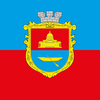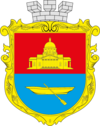Bolhrad
Bolhrad
Болград | |
|---|---|
 Transfiguration Cathedral | |
| Coordinates: 45°40′2″N 28°36′46″E / 45.66722°N 28.61278°E | |
| Country | |
| Oblast | Odesa Oblast |
| Raion | Bolhrad Raion |
| Hromada | Bolhrad urban hromada |
| Founded | 1821 |
| Area | |
• Total | 94 km2 (36 sq mi) |
| Elevation | 75 m (246 ft) |
| Population (2022) | |
• Total | 14,818 |
| • Density | 160/km2 (410/sq mi) |
| Time zone | UTC+2 (EET) |
| • Summer (DST) | UTC+3 (EEST) |
| Postcode district(s) | 68700—706 |
| Area code | +380-4846 |
 | |
Bolhrad (Ukrainian: Болград, romanized: Bolhrad, pronounced [boɫˈɦrɑd]; Bulgarian: Болград, romanized: Bolgrad; Romanian: Bolgrad, Gagauz: Bolgrad) is a small city in Odesa Oblast (province) of southwestern Ukraine, in the historical region of Budjak. It is the administrative center of Bolhrad Raion (district) and hosts the administration of Bolhrad urban hromada, one of the hromadas of Ukraine.[1] Population: 14,818 (2022 estimate).[2]
History
[edit]
Russian Empire (Bessarabia) 1821–1856
Principality of Moldavia 1856–1859
Romania 1859–1878
Russian Empire (Bessarabia) 1878–1917
Moldavian Democratic Republic 1917–1918
Kingdom of Romania 1918–1940
Soviet Union (Ukrainian SSR) 1940–1941
Kingdom of Romania 1941–1944
Soviet Union (Ukrainian SSR) 1944–1991
Ukraine 1991–present
Bolhrad was founded in 1821 by Bulgarian settlers in Bessarabia, under the direction of General Ivan Inzov who is "revered" by Bolhrad residents as the "Founder of Our City."[3] Bolhrad became part of Moldavia from 1856 to 1859, Romania from 1859 to 1878, 1918 to 1940, and 1941 to 1944, before being incorporated into the USSR (in the territory of the Ukrainian SSR), and later independent Ukraine. In 1921, there was a terrorist attack on a palace in the city.[4]
- Images of Romanian-times Bolhrad
-
Transfiguration Cathedral
-
Bolhrad High School
Demographics
[edit]| Year | Pop. | ±% |
|---|---|---|
| 1897 | 12,300 | — |
| 1930 | 14,280 | +16.1% |
| 1941 | 10,713 | −25.0% |
| 2001 | 17,353 | +62.0% |
| 2011 (est.) | 15,479 | −10.8% |
| Source: [5] | ||
The surrounding Bolhradsky district is predominantly populated by ethnic Bulgarians (a majority of 61%). Bolhrad itself is inhabited by a large number of Bessarabian Bulgarians and is considered by locals to be the unofficial capital of the Bessarabian historic district of Budjak.[citation needed]
In 1897, the ethnic make-up, by mother tongue, was 68.9% Bulgarian, 11.3% Russian, 9.7% Jewish, 5.0% Moldavian/Romanian, 2.5% Ukrainian, 1.0% Turkish, and 0.8% Polish.[5]
As of the 2001 Ukrainian census, Bulgarians still constitute the largest ethnic group in the city, accounting for almost half of the population. The second largest group are Ukrainians, closely followed by Russians. The towns also has a significant Moldovan and Gagauz population.[6][7]
According to the 2001 census, there was no language spoken by the majority of the population, which was composed of speakers of Russian (48.7%), Bulgarian (32.65%), Ukrainian (13.92%), Gagauz (2%) and Romanian (1.15%).[8] Most ethnic Ukrainians, Bulgarians and Gagauz were native speakers of the languages of their respective groups, but most ethnic Moldovans were Russian-speakers in 2001.[9]
Economy
[edit]As of 1920, Bolhrad has had a coal industry.[10]
Education
[edit]
The Georgi Sava Rakovski Bolhrad High School founded in 1858 is the oldest high school of the Bulgarian National Revival.[11][12]
Notable people
[edit]Natives
[edit]- Dimitar Grekov (1847–1901), Bulgarian politician
- Danail Nikolaev (1852–1942), Bulgarian general
- Georgi Todorov (1858–1934), Bulgarian general
- Vladimir Cavarnali (1910–1966), Bulgarian Romanian poet, journalist, and political figure
- Nicolae Văcăroiu (born 1943), former Prime Minister of Romania[13][14][15]
- Irina Molokanova (born 1957), Transnistrian politician
- Petro Poroshenko (born 1965), fifth President of Ukraine, entrepreneur and business oligarch
Residents
[edit]- Mykola Shmatko (1943-2020), Ukrainian visual artist
References
[edit]- ^ "Болградская городская громада" (in Russian). Портал об'єднаних громад України.
- ^ Чисельність наявного населення України на 1 січня 2022 [Number of Present Population of Ukraine, as of January 1, 2022] (PDF) (in Ukrainian and English). Kyiv: State Statistics Service of Ukraine. Archived (PDF) from the original on 4 July 2022.
- ^ Куемжи, Мария, Болградский Историко-Этнографический Музей (Bolhrad, Odes'ka Oblast, Ukraine; Фонд им. И.Н. Инзова, 2007)
- ^ "Bomb in Bolgrad Palace Kills 100 Guards, Report". Chicago Tribune. 14 December 1921. Retrieved 19 January 2017.
- ^ a b Первая Всеобщая перепись населения Российской империи, 1897 г. (in Russian). Vol. III. 1905. pp. 70–73.
- ^ See the 2001 census results by language by city at https://datatowel.in.ua/pop-composition/ethnic-cities
- ^ The Ukrainian census of 2001, ethnicity/nationality data by localities, at http://pop-stat.mashke.org/ukraine-ethnic2001.htm
- ^ See the 2001 census results by language by locality at https://socialdata.org.ua/projects/mova-2001/
- ^ See the 2001 census results by language by locality at https://socialdata.org.ua/projects/mova-2001/
- ^ Kaba, John (1919). Politico-economic Review of Basarabia. United States: American Relief Administration. p. 27.
- ^ Манолова, Надя; Красимира Табакова (2008). "150 години Болградска гимназия" (in Bulgarian). Държавна агенция за българите в чужбина. Archived from the original on April 11, 2009. Retrieved 2009-10-19.
- ^ "Болградска гимназия „Свети свети Кирил и Методий"". Българска енциклопедия А-Я (in Bulgarian). БАН, Труд, Сирма. 2002. ISBN 954-8104-08-3. OCLC 163361648.
- ^ Metaxa, Maia (25 September 2006). "Cetăţenia română şi trecerea frontierei după aderarea României la UE" [Romanian citizenship and border crossing after Romania's EU accession] (in Romanian). BBC. Retrieved 11 December 2024.
- ^ "Românul care a fost premier și președinte are o bătrânețe lipsită de griji. Pensia, de toată frumusețea". 10 November 2020.
- ^ "Nicolae Văcăroiu - Curriculum Vitae".







